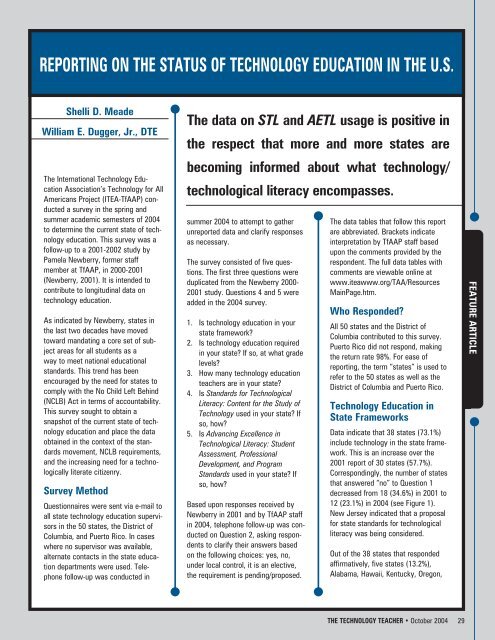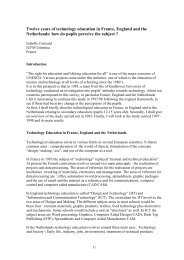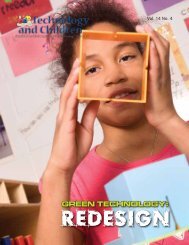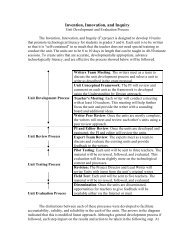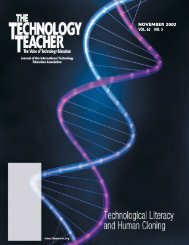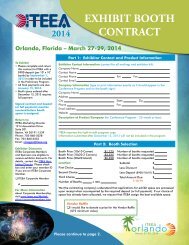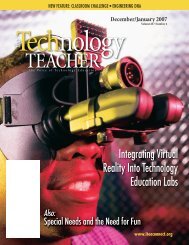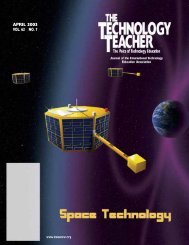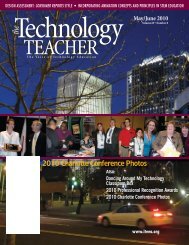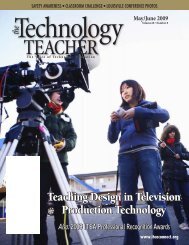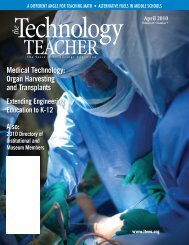October 2004 - Vol 64, No.2 - International Technology and ...
October 2004 - Vol 64, No.2 - International Technology and ...
October 2004 - Vol 64, No.2 - International Technology and ...
- No tags were found...
You also want an ePaper? Increase the reach of your titles
YUMPU automatically turns print PDFs into web optimized ePapers that Google loves.
REPORTING ON THE STATUS OF TECHNOLOGY EDUCATION IN THE U.S.Shelli D. MeadeWilliam E. Dugger, Jr., DTEThe <strong>International</strong> <strong>Technology</strong> EducationAssociation’s <strong>Technology</strong> for AllAmericans Project (ITEA-TfAAP) conducteda survey in the spring <strong>and</strong>summer academic semesters of <strong>2004</strong>to determine the current state of technologyeducation. This survey was afollow-up to a 2001-2002 study byPamela Newberry, former staffmember at TfAAP, in 2000-2001(Newberry, 2001). It is intended tocontribute to longitudinal data ontechnology education.As indicated by Newberry, states inthe last two decades have movedtoward m<strong>and</strong>ating a core set of subjectareas for all students as away to meet national educationalst<strong>and</strong>ards. This trend has beenencouraged by the need for states tocomply with the No Child Left Behind(NCLB) Act in terms of accountability.This survey sought to obtain asnapshot of the current state of technologyeducation <strong>and</strong> place the dataobtained in the context of the st<strong>and</strong>ardsmovement, NCLB requirements,<strong>and</strong> the increasing need for a technologicallyliterate citizenry.Survey MethodQuestionnaires were sent via e-mail toall state technology education supervisorsin the 50 states, the District ofColumbia, <strong>and</strong> Puerto Rico. In caseswhere no supervisor was available,alternate contacts in the state educationdepartments were used. Telephonefollow-up was conducted inThe data on STL <strong>and</strong> AETL usage is positive inthe respect that more <strong>and</strong> more states arebecoming informed about what technology/technological literacy encompasses.summer <strong>2004</strong> to attempt to gatherunreported data <strong>and</strong> clarify responsesas necessary.The survey consisted of five questions.The first three questions wereduplicated from the Newberry 2000-2001 study. Questions 4 <strong>and</strong> 5 wereadded in the <strong>2004</strong> survey.1. Is technology education in yourstate framework?2. Is technology education requiredin your state? If so, at what gradelevels?3. How many technology educationteachers are in your state?4. Is St<strong>and</strong>ards for TechnologicalLiteracy: Content for the Study of<strong>Technology</strong> used in your state? Ifso, how?5. Is Advancing Excellence inTechnological Literacy: StudentAssessment, ProfessionalDevelopment, <strong>and</strong> ProgramSt<strong>and</strong>ards used in your state? Ifso, how?Based upon responses received byNewberry in 2001 <strong>and</strong> by TfAAP staffin <strong>2004</strong>, telephone follow-up was conductedon Question 2, asking respondentsto clarify their answers basedon the following choices: yes, no,under local control, it is an elective,the requirement is pending/proposed.The data tables that follow this reportare abbreviated. Brackets indicateinterpretation by TfAAP staff basedupon the comments provided by therespondent. The full data tables withcomments are viewable online atwww.iteawww.org/TAA/ResourcesMainPage.htm.Who Responded?All 50 states <strong>and</strong> the District ofColumbia contributed to this survey.Puerto Rico did not respond, makingthe return rate 98%. For ease ofreporting, the term “states” is used torefer to the 50 states as well as theDistrict of Columbia <strong>and</strong> Puerto Rico.<strong>Technology</strong> Education inState FrameworksData indicate that 38 states (73.1%)include technology in the state framework.This is an increase over the2001 report of 30 states (57.7%).Correspondingly, the number of statesthat answered “no” to Question 1decreased from 18 (34.6%) in 2001 to12 (23.1%) in <strong>2004</strong> (see Figure 1).New Jersey indicated that a proposalfor state st<strong>and</strong>ards for technologicalliteracy was being considered.Out of the 38 states that respondedaffirmatively, five states (13.2%),Alabama, Hawaii, Kentucky, Oregon,FEATURE ARTICLETHE TECHNOLOGY TEACHER • <strong>October</strong> <strong>2004</strong> 29


